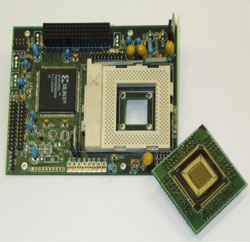| |
Ultra-High-Speed Image Processing: Over 10 000 Frames Per Second
by Ákos Zarándy and Róbert Fekete
Cellular Visual Microprocessor (CVM) technology allows extremely high processing speeds to be reached in industrial applications of machine vision systems. These applications are being developed as part of a larger series of development projects carried out by AnaLogic Computers Ltd, a spin-off company of SZTAKI’s Analogical and Neural Computing Systems Laboratory.
Machine vision systems are widely used in industry for quality assurance and process control, among other applications. Such systems usually consist of one or more cameras, a framegrabber card, a PC, and the image-processing software. However, compact 'smart' cameras are also appearing on the market, which integrate the above components into a single, compact unit that can autonomously perform certain tasks such as fault detection. In these novel devices, the image-processing algorithms are most often performed by a digital signal processor (DSP), or as in our case, by a Cellular Visual Microprocessor (CVM).
Until now, the automation of multiple processes, production steps, or product inspections was hindered by two main obstacles:
- the algorithms to be utilised were computationally too intensive compared to the capacity of computers
- often the inspection requirement of the processes required a much higher rate of sampling than the sensors and cameras were capable of handling.
These barriers have now been overcome with the introduction of the CVM technology. CVMs have the ability to capture and process several thousand images per second in real time, while common digital vision systems usually provide only one to two hundred processed images per second.
CVMs are essentially CMOS sensors with an integrated image processor. The image processor is a cellular neural network-based image-processing array, and consists of several identical processor elements. When performing an operation on an image, an everyday processor (like that of a PC) performs the operation on the pixels one by one. In the processor array of the CVM, every pixel of the picture is handled by a different processor element, meaning the operation can be performed simultaneously for every pixel. The individual processor elements are also directly interconnected with their nearest neighbours, enabling high-speed local operations.
 |
| Figure 1: Spark plug and the detected discharge (gas and surface discharge). |
Owing to the parallel architecture and the local connectivity, the CVM can perform operations on the full image in a few microseconds. Its computing capacity is the equivalent of 1012 digital operations per second. The CVM can store programs like common computers, and can be programmed from common development environments, using either native or the well-known C and C++ languages.
As an example, a CVM’s extremely high speed is capable of detecting and classifying the millisecond-long discharges in the spark plugs of cars (Figure 1). The high-quality time resolution also makes it possible to inspect the build-up of the discharges. The images of the figure were captured by the first prototype of the CVM, a binary system with 20x22 pixel resolution. The testing measurements of a new 128x128 pixel CVM, which is capable of capturing and processing greyscale images, are currently in their final phase (Figure 2). Both of these CVM chips were designed in IMSE-CNM Seville, Spain.
 |
| Figure 2: The 128x128 pixel Cellular Visual Microprocessor and its testing board. |
Based on this novel technology, a wide range of applications in a number of areas is being developed. CVMs can be utilised in any context requiring high frame-rate and fast processing. Some examples include:
- monitoring of passenger position and airbag control for the automotive industry, eg, determining if the airbag can be opened without harming the passenger
- quality control in the textile industry, eg, detecting faults in yarn and weaving, as well as knots, dirt etc
- terrain recognition and classification for autonomous navigation of unmanned vehicles
- position detection for robot control.
Link:
http://www.analogic-computers.com
Please contact:
Ákos Zarándy and Róbert Fekete
AnaLogic Computers Ltd., Budapest
Tel: +36 1 279 6131
E-mail: info@analogic-computers.com
|




